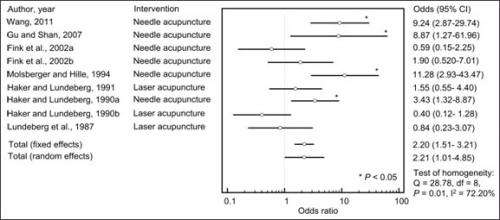Researchers compare analgesic effect of manual vs laser acupuncture lateral epicondylalgia

A team of researchers from China Medical University and Da-Chien General Hospital in Taiwan (R.O.C.) recently compared the analgesic effect of laser acupuncture and manual acupuncture for the treatment of lateral epicondylalgia. Manual acupuncture is effective in short-term pain relief for the treatment of lateral epicondylalgia.
The acupuncture increases endorphin secretion to relieve pain and affects the pathway of the Aδ nerve fiber to inhibit painful sensation and relieves pain in certain body regions. The acupuncture causes a De Qi sensation and a sour and warm feeling at the acupuncture point. It is critical in pain relief because it activates the descending pain inhibitory system in the central nervous system.
Low-level laser therapy for laser acupuncture has been recently used for treatment of orthopedic diseases. Compared with manual acupuncture, laser therapy applied to the acupuncture point has more advantages because it is painless, aseptic, safe, dosage adjustable, and user friendly. The pain relief achieved using laser acupuncture is related to the metabolism of adenosine triphosphate because it encourages the myofascial trigger point to absorb energy and thereby causes local hypoxia to increase blood circulation, which subsequently decreases the pain caused by lateral epicondylalgia.
The team conducted a systematic review and meta-analysis to compare the analgesic effect of laser acupuncture and manual acupuncture for treating lateral epicondylalgia. We investigated studies in the Medline, PubMed, and CINAHL databases, published from January 1980 to December 2013.
Based on these statistics, the research team calculated the experimental event rate (EER), control event rate (CER), absolute risk reduction (ARR), and relative risk reduction (RRR) of the studies and analyzed the number needed to treat (NNT). The total effect was calculated by a total random effect model to assume the analgesic effect of laser acupuncture and manual acupuncture. The results indicated that manual acupuncture exhibited a substantial difference in treatment effect.
According to the Philadelphia Panel Classification System, they assigned as evidence-based results:
- The short-term effect of manual acupuncture on the relief of pain caused by lateral epicondylalgia is Level B
- The long-term effect of manual acupuncture of the relief of pain caused by lateral epicondylalgia is Level C+
- The analgesic effect of laser acupuncture in treating lateral epicondylalgia is Level D
- The analgesic effect of manual acupuncture on the treatment of lateral epicondylalgia is Level B.
Manual acupuncture immediately relieves the pain of lateral epicondylalgia, but its long-term analgesic effect is unremarkable. Applying it at a suitable acupuncture point and to an optimal acupuncture depth can effectively treat lateral epicondylalgia. The study indicates that manual acupuncture applied to lateral epicondylalgia produces stronger evidence of pain relief than the laser acupuncture does.
















